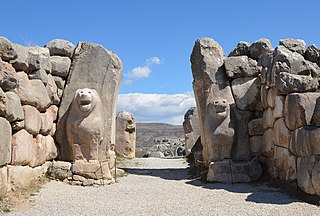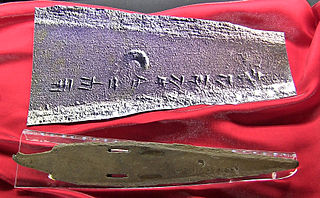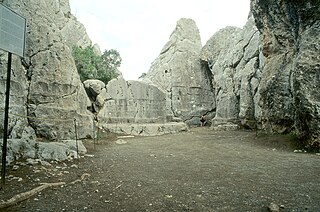
The Hittites were an Anatolian people who played an important role in establishing first a kingdom in Kussara, then the Kanesh or Nesha kingdom, and next an empire centered on Hattusa in north-central Anatolia. This empire reached its height during the mid-14th century BC under Šuppiluliuma I, when it encompassed an area that included most of Anatolia as well as parts of the northern Levant and Upper Mesopotamia.

Kültepe, also known as Kanesh or Nesha, is an archaeological site in Kayseri Province, Turkey, inhabited from the beginning of the 3rd millennium BC, in the Early Bronze Age. The nearest modern city to Kültepe is Kayseri, about 20km southwest. It consisted of an Upper city, and a lower city, where an Assyrian kārum, trading colony, was found. Its ancient names are recorded in Assyrian and Hittite sources. In cuneiform inscriptions from the 20th and the 19th century BC, the city was mentioned as Kaneš (Kanesh); in later Hittite inscriptions, the city was mentioned as Neša, or occasionally as Aniša (Anisha). In 2014, the archaeological site was inscribed in the Tentative list of World Heritage Sites in Turkey. It is the place where the earliest record of a definitively Indo-European language has been found, Hittite, dated to the 20th century BC.

Mitanni, c. 1550–1260 BC, earlier called Ḫabigalbat in old Babylonian texts, c. 1600 BC; Hanigalbat or Hani-Rabbat in Assyrian records, or Naharin in Egyptian texts, was a Hurrian-speaking state with Indo-Aryan linguistic influences in northern Syria and southeast Anatolia. Since no histories or royal annals/chronicles have yet been found in its excavated sites, knowledge about Mitanni is sparse compared to the other powers in the area, and dependent on what its neighbours commented in their texts.

The Battle of Kadesh or Battle of Qadesh took place between the forces of the New Kingdom of Egypt under Ramesses II and the Hittite Empire under Muwatalli II at the city of Kadesh on the Orontes River, just upstream of Lake Homs near the modern Lebanon–Syria border.

Hattusa was the capital, during two periods, of the Hittite Empire in the late Bronze Age. Its ruins lie near modern Boğazkale, Turkey, within great loop of the Kızılırmak River. Hattusa was added to the UNESCO World Heritage Site list in 1986.

Tyana, earlier known as Tuwana and Tuwanuwa was an ancient city in the Anatolian region of Cappadocia, in modern Kemerhisar, Niğde Province, Central Anatolia, Turkey. It was the capital of a Luwian-speaking Neo-Hittite kingdom in the 1st millennium BC.
Tudhaliya I was a king of the Hittite Empire in c. the early 14th century BC.
Telipinu was the last king of the Hittites Old Kingdom, living in 16th century BC, reigned c. 1525-1500 BC in middle chronology. At the beginning of his reign, the Hittite Empire had contracted to its core territories, having long since lost all of its conquests, made in the former era under Hattusili I and Mursili I – to Arzawa in the West, Mitanni in the East, the Kaskians in the North, and Kizzuwatna in the South.

Anitta, son of Pitḫana, reigned ca. 1740–1725 BC, and was a king of Kuššara, a city that has yet to be identified. He is the earliest known ruler to compose a text in the Hittite language.

Yazılıkaya was a sanctuary of Hattusa, the capital city of the Hittite Empire, today in the Çorum Province, Turkey. Rock reliefs are a prominent aspect of Hittite art, and these are generally regarded as the most important group.

Hittite mythology and Hittite religion were the religious beliefs and practices of the Hittites, who created an empire centered in what is now Turkey from c. 1600–1180 BC.
Kizzuwatna was an ancient Anatolian kingdom in the 2nd millennium BC. It was situated in the highlands of southeastern Anatolia, near the Gulf of İskenderun, in modern-day Turkey. It encircled the Taurus Mountains and the Ceyhan River. The centre of the kingdom was the city of Kummanni, in the highlands. In a later era, the same region was known as Cilicia.
Muwatalli I was a king of the Hittites.

Sapinuwa was a Bronze Age Hittite city at the location of modern Ortaköy in the province Çorum in Turkey about 70 kilometers east of the Hittite capital of Hattusa. It was one of the major Hittite religious and administrative centres, a military base and an occasional residence of several Hittite kings. The palace at Sapinuwa is discussed in several texts from Hattusa.

Nerik was a Bronze Age settlement to the north of the Hittite capitals Hattusa and Sapinuwa, probably in the Pontic region. Since 2005–2009, the site of Nerik has been identified as Oymaağaç Höyük, on the eastern side of the Kızılırmak River, 7 km (4.3 mi) northwest of Vezirköprü.

Šamuḫa is an ancient settlement near the village of Kayalı Pinar, c. 40 km west of Sivas, in the Sivas Province of Turkey. Located on the northern bank of Kizil Irmak river, it was a city of the Hittites, a religious centre and, for a few years, a military capital for the empire. Samuha's faith was syncretistic. Rene Lebrun in 1976 called Samuha the "religious foyer of the Hittite Empire".

Zalpuwa, also Zalpa, was a still-undiscovered Bronze Age city in Anatolia of around the 18th century BC. Its history is largely known from the Proclamation of Anitta, CTH 1. But the Zalpa mentioned in the Annals of Hattusili I, CTH 4, is now convincingly identified as Tilmen Höyük, in the Karasu River Valley south of the Taurus Mountains by Tubingen and Chicago Universities recent excavations.
Zidanta II was a king of the Hittites in the 15th century BC.

The Nineteenth Dynasty of Egypt, also known as the Ramessid dynasty, is classified as the second Dynasty of the Ancient Egyptian New Kingdom period, lasting from 1292 BC to 1189 BC. The 19th Dynasty and the 20th Dynasty furthermore together constitute an era known as the Ramesside period. This Dynasty was founded by Vizier Ramesses I, whom Pharaoh Horemheb chose as his successor to the throne.